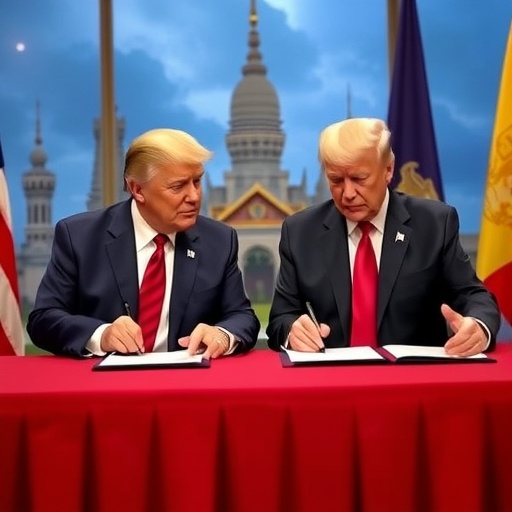Trump Signs Landmark Trade Agreements with Thailand and Cambodia, Strengthening US Influence in Southeast Asia Through Critical Minerals Deal
In a strategic pivot that’s reshaping America’s footprint in one of the world’s fastest-growing regions, President Donald Trump has inked groundbreaking trade agreements with Thailand and Cambodia. Announced during a high-profile summit in Washington, D.C., these pacts not only promise to boost bilateral trade by an estimated $15 billion over the next five years but also include a pivotal deal on critical minerals, aimed at countering China’s dominance in global supply chains. This move comes amid escalating geopolitical tensions and underscores Trump‘s commitment to expanding US economic leverage in Southeast Asia.
The agreements, signed on Tuesday in the presence of Thai Prime Minister Srettha Thavisin and Cambodian leader Hun Manet, mark a significant escalation in US-Thailand and US-Cambodia relations. Officials from the US Trade Representative’s office highlighted that the deals will facilitate smoother access to Southeast Asian markets for American exporters, particularly in agriculture, technology, and manufacturing sectors. “This is about creating win-win opportunities that secure American jobs and innovation while fostering stability in a vital region,” Trump declared during the signing ceremony, emphasizing the pacts’ role in diversifying supply chains away from adversarial powers.
According to preliminary estimates from the US Department of Commerce, the trade agreements could increase US exports to Thailand by 25% and to Cambodia by 40% by 2028. These figures are bolstered by tariff reductions on over 500 product categories, including electronics, apparel, and automotive parts. The inclusion of the critical minerals component is particularly noteworthy, as it addresses the US’s growing dependency on rare earth elements essential for everything from electric vehicles to defense technologies.
Unlocking Critical Minerals: A Game-Changer for US Supply Security
At the heart of these trade agreements lies a dedicated critical minerals deal that could redefine global resource dynamics. Thailand and Cambodia, rich in deposits of lithium, cobalt, and rare earths, have committed to joint exploration and extraction projects with US firms. Under the pact, the US will invest $2.5 billion in mining infrastructure over the next decade, with initial funding allocated to a lithium processing plant in Cambodia’s Mondulkiri province and rare earth refining facilities in Thailand’s northern highlands.
Experts note that this initiative is a direct response to China’s control over 80% of the world’s rare earth processing capacity. “The critical minerals agreement with Thailand and Cambodia isn’t just trade—it’s a strategic hedge against supply disruptions,” said Dr. Elena Vasquez, a senior fellow at the Brookings Institution’s Global Economy program. “By partnering with these nations, the US is tapping into untapped reserves that could meet 15-20% of domestic demand for battery-grade minerals by 2030.”
The deal includes provisions for technology transfers, where US companies like Tesla and General Motors will collaborate with local partners to develop sustainable mining practices. Environmental safeguards are embedded, mandating adherence to international standards to mitigate ecological impacts in biodiversity hotspots. Cambodian officials have already greenlit exploratory drilling in the Cardamom Mountains, with first outputs expected by mid-2025. This collaboration extends to research hubs, fostering innovation in mineral recycling and alternative sourcing methods.
From an economic standpoint, the critical minerals focus is projected to create over 10,000 jobs in the region, with ripple effects benefiting US manufacturers. For instance, reduced reliance on Chinese imports could lower costs for American electric vehicle producers by up to 12%, according to a recent report from the American Battery Technology Council. Thai exporters, meanwhile, stand to gain from enhanced market access, with commitments to supply 50,000 tons of processed minerals annually to US ports starting in 2026.
Trade Agreements Boost Bilateral Flows: From Agriculture to Tech Exports
Beyond minerals, the broader trade agreements encompass a wide array of sectors designed to invigorate economic ties. Thailand, a key US trading partner with $60 billion in annual bilateral trade, will see lowered barriers for American agricultural products like soybeans and corn, which faced previous non-tariff hurdles. The pact eliminates a 10% duty on US pork exports, potentially increasing shipments by 30%, as per USDA projections.
Cambodia’s agreement, valued at an initial $5 billion in new trade volume, targets its burgeoning textile and garment industry. US apparel brands will benefit from streamlined customs procedures, reducing processing times from 72 hours to under 24. “These trade agreements with Thailand and Cambodia open doors that were previously bolted shut,” noted US Commerce Secretary Gina Raimondo in a post-signing briefing. “We’re talking about real growth—$8 billion in additional exports for American farmers and manufacturers alone.”
Technology transfer clauses are another highlight, allowing US firms to establish joint ventures in Cambodia’s Sihanoukville Special Economic Zone for semiconductor assembly. This aligns with Trump’s broader “America First” agenda by repatriating some supply chain elements while investing abroad. Statistical data from the World Bank indicates that such pacts could accelerate GDP growth in both countries by 1.5-2% annually, with US influence expanding through infrastructure loans totaling $1 billion from the Export-Import Bank.
Stakeholders in the private sector are optimistic. “The agreements provide the certainty we’ve needed to scale operations in Southeast Asia,” said Mark Harlan, CEO of AgriTech Solutions, a US-based agribusiness firm eyeing Thai rice markets. Challenges remain, however, including navigating local labor laws and intellectual property protections, but dispute resolution mechanisms in the pacts aim to address these proactively.
US Facilitates Peace Negotiations: Linking Trade to Regional Stability
Trump’s diplomatic maneuvering extends beyond economics, as the trade agreements dovetail with US efforts to broker peace in Southeast Asia. The pacts include clauses supporting trilateral dialogues on border disputes between Thailand and Cambodia, longstanding flashpoints that have occasionally escalated into military standoffs. By tying economic incentives to stability, the US is positioning itself as a mediator, much like its role in the Abraham Accords.
During the summit, Trump hosted a side session where Thai and Cambodian leaders reaffirmed commitments to de-escalate tensions around the Preah Vihear temple region. “Trade and peace go hand in hand; instability hurts everyone,” Trump stated, announcing $500 million in US aid for joint border security initiatives. This includes training programs for peacekeeping forces and satellite monitoring technology to prevent incursions.
Analysts praise this integrated approach. “President Trump’s trade agreements with Thailand and Cambodia are a masterstroke in soft power,” opined Professor Liam Chen from Georgetown University’s Asian Studies Center. “By facilitating peace negotiations, the US not only secures economic gains but also counters Chinese expansionism in the South China Sea.” Historical context reveals that similar US interventions in the 1990s helped normalize relations post-Khmer Rouge era, and today’s deals build on that legacy.
The peace element also extends to broader ASEAN dynamics, with invitations for Vietnam and Laos to join ancillary mineral exploration talks. This multilateral angle could foster a US-led bloc, enhancing collective bargaining against regional threats. Cambodian Foreign Minister Sok Chenda Sophea echoed this sentiment: “These agreements, under President Trump’s leadership, pave the way for a prosperous and peaceful Southeast Asia.”
Expert Reactions and Global Implications for US Strategy
The international community has responded with a mix of acclaim and scrutiny. In Brussels, EU trade officials expressed concerns over potential market distortions, urging the US to align with WTO standards. Domestically, bipartisan support is evident, with Senate Foreign Relations Committee Chair Bob Menendez calling the deals “a vital step in diversifying away from China.”
Economists forecast that the critical minerals deal could shave 5-7% off US import costs for rare earths, bolstering competitiveness in green tech. A study by the Peterson Institute for International Economics projects $20 billion in cumulative benefits by 2035, including job creation in mining-dependent states like Nevada and Texas. However, environmental groups like Greenpeace warn of risks to indigenous communities, advocating for stricter oversight.
From a geopolitical lens, these agreements signal a Trump doctrine of economic diplomacy. By expanding US influence in Southeast Asia, the pacts challenge Beijing’s Belt and Road Initiative, which has invested heavily in Thai and Cambodian infrastructure. “This is Trump’s way of drawing a line in the sand—trade as a tool for security,” said retired Admiral James Stavridis, former NATO Supreme Allied Commander.
Business leaders are mobilizing quickly. The US Chamber of Commerce has launched a Southeast Asia Task Force to guide investments, while tech giants like Apple explore sourcing components from new Cambodian facilities. Trade volumes are already ticking up, with a 12% surge in US-Thailand cargo shipments reported in the weeks leading to the signing.
Looking forward, these trade agreements set the stage for deeper integration. Upcoming summits in Bangkok and Phnom Penh will refine implementation details, potentially incorporating digital trade protocols and climate resilience measures. As Trump eyes legacy-building initiatives, the pacts with Thailand and Cambodia could catalyze a renaissance in US-Asia relations, ensuring American prosperity amid global shifts. With critical minerals secured and peace pathways illuminated, the region—and the world—watches as this bold strategy unfolds.








